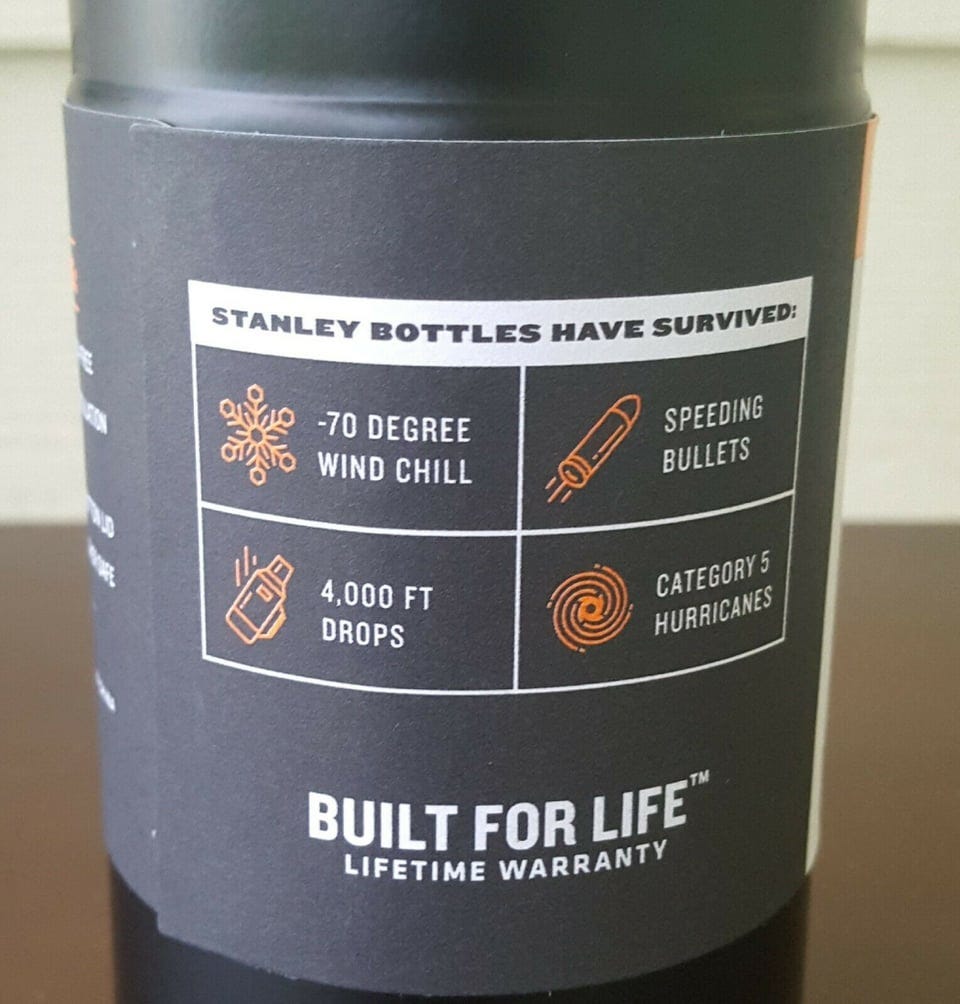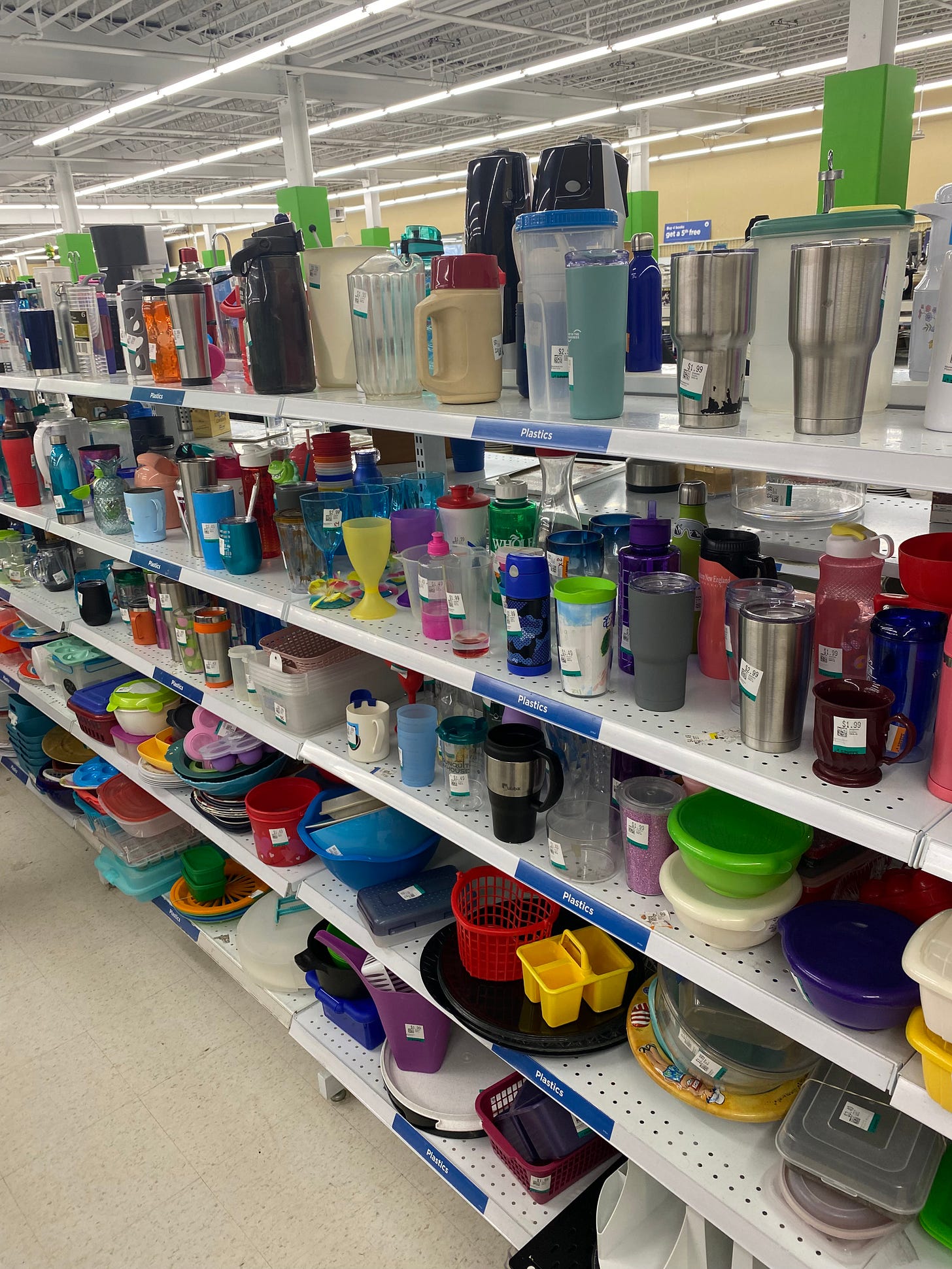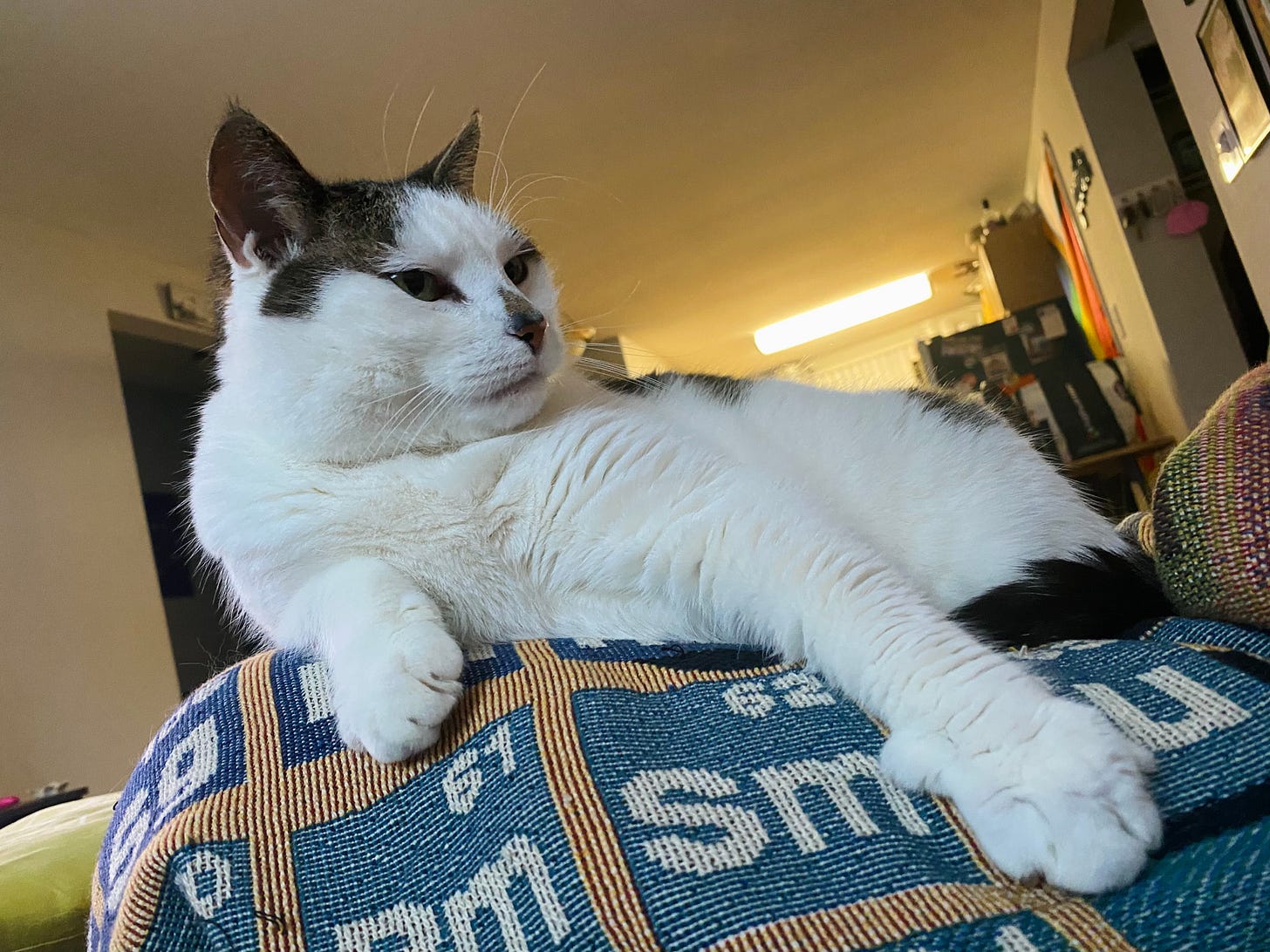Real quick up top: I was featured in a news story about microplastics in plastic water bottles! Check it out to read why plastic bottles are harmful to your health, and how you can mitigate these risks! https://www.verywellhealth.com/bottled-water-contains-plastic-particles-8546698
We’re all trying to fill the void in our own ways. Some do it with drugs and alcohol, some do it with Funko Pops, some do it with obsessive skin care routines, and some do it with Stanley Cups.
By now, you’ve likely seen the viral videos: swarms of young women crowding around a display stand to acquire a hot pink tumbler. Collections of ten, twenty, thirty, more Stanley Cups, all to display on a shelf rather than drink from. And of course, Danielle Lettering, the young woman who had a tragic car fire, only to pull her invincible Stanley out of the cup holder and demonstrate that the ice inside had not melted in the heat, who was then gifted a new car by the CEO of Stanley. (At least now I know how to go viral!)
The “Stanley Cup Craze” has, of course, drawn somewhat of a backlash online. It’s not unfair to point out how this falls into the regular toxic discourse around Things Women Be Doing. From Twilight to Ugg Boots to pumpkin spice lattes, any social trend led by women is vigorously dunked upon by people of all ages. There’s usually a “main reason”, of course; Twilight features a toxic age gap relationship, purchasing too many Stanley Cups is counter-intuitively bad for the environment, so on and so forth. But two things can be true at once: just because there are real criticisms to be made of “The Stanley Cup Craze” doesn’t mean that there isn’t misogyny at play as well; men are out here enacting six-figure sales of Pokémon cards, but a few women start buying cups and all of a sudden every commentary YouTuber has to make a video about it.
Still, if (like me) you’re interested in sustainability, riding a social media wave is a good way to get your message out there. People are talking about Stanley Cups? Let’s use this as a chance to talk about overconsumption! It’s the perfect symbiotic relationship: women who are alienated under a misogynistic, consumerist culture fill the void with products, environmental activists make videos about them (partially to make a good point about consumerism, but also often to mock women), the women become further alienated, and the cycle continues. I’m personally very much looking forward to the next time we all start talking about fast fashion again, only to forget about it the next day.
I don’t want to get too down on online activist culture. Social media can be a great tool for sharing your perspective and getting the message out there; I just find myself wondering if we’re ever truly reaching the right people. Let’s talk about class.
The Stanley Cup brand started in 1913 and had always marketed itself to working class men. Ads from the 1970s showed the tumbler getting knocked around at a construction site, falling off buildings into rebar and wheelbarrows, only to end up in the hands of a plaid-shirted Man’s Man, who takes a satisfying sip from a totally-intact canister of coffee. The product’s label proudly states that it’s survived gunfire, hurricanes, multi-thousand foot drops, and more. The Military Antiques Museum in Petaluma, CA displays an “original WWII Stanley thermos that was issued to bomber crews to keep their coffee hot at the high altitudes”. Despite the hyper-masculine legacy of the Stanley brand, you can draw a direct line between the 1978 construction site ad and the viral post-explosion car video: these cups are goddamn invincible, invest now!

How did such a masculine, working-man/nature-lover’s brand become associated with upper-middle-class white women? Mommy bloggers, of course; in the late 2010s, the creators of the Instagram page “The Buy Guide” loved the cup and thought it should be more popular than it was. As legend has it, the group purchased a Stanley for a Bachelor contestant, which got someone who works at Stanley to say “Hey, that’s our cup! Maybe we should get on this whole influencer marketing thing…” and ultimately give thousands of tumblers to The Buy Guide to sell through their website. The rest is history, with a rise in women’s obsession with hydration rising even further with the 2023 WaterTok trend, and crescendoing with Lettering’s viral car explosion.
One can wonder, from “The Buy Guide” authors to Danielle Lettering, that random, unpaid women are doing what should be the work of advertising agencies. At least Lettering was “compensated” (??) for her 95-million-view video that launched Stanley into the stratosphere. But if you think about it, everybody’s who’s made a Stanley Cup video, positive or negative, influencer or civilian, is essentially making an advertisement for the Stanley Cup, for free. This newsletter, unfortunately, is getting YOU, right now, to think about Stanley Cups! STANLEY CUPS!!! Organic marketing saves the day again.
Clearly, this change was successful: what was once a masculine, yet seemingly-pro-sustainability company that launched camo-themed collections with hunting and fishing brand Mossy Oak is now available in every color of the rainbow and collaborating with Starbucks, the Pumpkin Spice Lord itself. There’s even a huge market for Stanley accessories, so now you can treat your invincible car-fire-surviving cup with the gentle care of a newborn baby.
For me, the most egregious of these practices came in the form of a TikTok user who laminated the label of her tumbler, backgrounded with the song “My Love Mine All Mine” by Mitski, implying a deep, almost romantic relationship with a designed-to-be-discardable piece of paper that serves mainly to host a bar code for a cashier to scan. As YouTuber Chad Chad quipped, as if disposable packaging weren’t enough, we now apparently have to make our trash immortal with plastic that will take thousands of years to degrade in the environment.
The environmental angle can’t be ignored: plastic water bottles are bad for the environment and your health (again, I just contributed to a very science-filled news article about it, which you should go read!) so drinking out of a metal bottle (and cleaning it regularly to prevent bacterial buildup!!) is better for you and the planet. Full stop!
Where most people have a problem is that this once-sustainable brand that you could conceivably pass down to a new generation like a cast iron pan is now something people are collecting by the dozen. Plastic bottles are bad for the environment, but if most of these tumblers end up in a landfill—which they surely will after they end up in thrift stores in 5 years—that won’t exactly be great either.
Where I have a problem is that, while pointing this out is ultimately good, our analysis usually stops at “look at what these dumbass women are doing” and not “Why are people behaving in this way? What are the incentive structures in society that cause overconsumption? What hole are these people trying to fill within themselves?” I wish we could write stories like these in a way that is both sympathetic towards women, pointing out the roles that misogyny plays in shaping discourse while also pointing out the relationships between gender, class, race, and consumption. After all, it’s not just women who are buying (and sometimes stealing) Stanleys by the dozens; it’s upper-middle-class, white women.

We can tell this whole story over again through another recent viral trend: discussions of “Sephora Kids”. Starting with a video by Chloe Grace, internet users started pointing out how young girls were acting spoiled in makeup stores, usually by ruining tester samples and causing a scene when their parents refuse to buy them all the products they want. The business blog Axios posits that girls age 10-13 have “become an economic force far beyond the Stanley craze”, selecting cheaper, influencer-marketed products befitting of their “lower purchasing power”. It’s dark and dystopian to see that girls as young at ten are buying anti-aging products, and dermatologists having to drop what they’re doing to warn people about the dangers of retinol on young skin.
“Is the next generation growing up too fast?” posits Grace’s video caption. “Is the next generation screwed?” posits others, a line of questioning stretching back as far as ancient history. But again, let’s talk about class.
First, more history: The word “teenager” actually didn’t exist until after World War One. Before then, at least in my part of the world, there were children (who went to school) and there were adults (who had a job and could spend money). A post-war economic boom allowed people in their teen-years to get jobs and make money. This created a new type of buyer who, instead of buying groceries or cars, were buying soda pop, radios, and magazines. Advertising agencies saw this new, growing economic demographic and decided to market to them directly, with publications like “Teenager” cementing the idea of the “teenager” as an age group. Consumerism, and to an extent the violence of war, created a type of person. Similarly, “Millennial” was a term invented by two marketing gurus (Neil Howe and William Strauss) to describe the consumer behavior of people born during the 1980s. Marketing doesn’t just show you products that might be useful to you, shapes human behavior by introducing language and ideas into the zeitgeist. Marketing introduces you to a problem that you didn’t have so that you can be sold a solution.
There’s nothing new under the sun: Millennials and Zoomers loathe sitting through advertisements and value authenticity (more so than previous generations), so now brands use influencer marketing to provide a veneer of authenticity (“I’m not a paid actor, I’m a person like you, and I love this beauty product!”) And thanks to a variety of incentive structures (such as the economic precarity of modern life requiring both parents to have jobs and a lack of child care in my country), “KIDS THESE DAYS” are being raised by iPads and are bombarded by ads that they can’t tell are ads. This is why the products that tween girls are going sicko mode in Sephora for—Drunk Elephant, Rare Beauty, et al.—are the ones they see via influencer marketing on TikTok; their favorite people are doing it, so why can’t they?
This is why I don’t see the value in dunking on ten-years-olds. Little kids are, quite famously, unable to emotionally regulate themselves, which is why parents and other caretakers have to teach them such things. If a girl is acting out in a Sephora, they aren’t a “spoiled brat”, they’re just a frustrated child who needs a kind but firm voice to guide them towards emotional maturity. Very many people are quick to blame literal children for their actions in public, but seemingly very few people want to truly understand how we got here.
The answer, of course, is that we’ve been here all along. Women have been pressured into hyperfixating on their presentation for ages, and this is merely a more dystopian extension of that. Most people like to think that sexism is part of the human condition; men are from Mars and women are from Venus, we are destined to quarrel for the rest of time. But you guess what a trans feminist’s thoughts on that are. In fact, beauty standards are not a bad starting point for this discussion: ten thousand years ago, at the dawn of human civilization, there were no razor blades to shave your legs with, nor contouring kits to shape your face with. There was no reason to focus on aesthetics when we were hanging out in caves or moving nomadically across the continents in search of food. At some point, beauty standards—and by association, sexism itself—had to be invented. At some point, men had to take over and demand that women look a certain way in order to be desired. At some point, men created the economic conditions for women to be dependent on men—they passed laws forbidding women to own homes or their own money. Oh yeah, and they invented money and homelessness. At some point, men had to say, “do things things for us, maintain our homes and dress this way, or else you’ll be left behind, hungry, houseless, and lonely”.
One final history lesson: Until very recently in human history, we had the very rich–people who hoarded wealth and power and filled their giant homes with a bunch of useless, shiny garbage–and you had everyone, living minimally and only “consuming” the meager goods they could afford. But then, starting with industrialization and vastly accelerated by the post-World War 1 economic boom, everyday people could afford to fill their homes with shiny garbage too! Except instead of buying lavish mansions and handbags worth thousands of dollars, we could only afford shiny garbage made of cheaper materials, like plastic and aluminum (befitting of our “lower purchasing power”, to use Axois’ business terminology). It also helped that Western countries put out loads of propaganda saying that if you didn’t buy a lot of shiny garbage, you were a “bad American” or whatever, because stimulating the economy and putting more money into the pockets of the rich is highly desirable.
This has only gotten worse in the 21st century, now that we can buy goods online with zero concept of the working conditions that produced these goods; every time you buy something on Amazon it starts a Rube-Goldberg machine of human suffering, but you never have to see it, so it’s fine! Just look at fashion: sure, the quality of the material is objectively worse than it was even just 30 years ago, and sure, the people who make those clothes are working for slave wages and are slowly being poisoned. But on the plus side, it’s easier than to cosplay as a rich person!
Stanley cups, clear/light skin, owning lots of clothes (albeit made of polyester), Starbucks beverages, Ugg boots…these are all class signifiers. We mentally associate having lots of stuff with being wealthy, which we associate with security and superiority, which we associate with happiness. And that’s why the planet’s on fire, Timmy!
Obviously, these are all entangled with being signifiers for whiteness as well. Unlike other cultures—which have, you know, culture—white people have no culture, so our culture is defined by the stuff we own. Furthermore, the relationship between the makeup industry and whiteness is well-trodden territory, from skin-lightening creams to foundations not being available in darker shades to the “clean girl” TikTok trend. We kill the planet—and each other, and ourselves—through overconsumption because outside of our stuff, we don’t know who we are.
What capitalism promises us, which is can never truly fulfill, is an antidote to loneliness. Capitalism strips us of our third spaces, strips us of our relations and obligations to each other by making us see all interactions as transactional. It alienates us from our labor, forcing us into back-breaking work with no health care or soul-crushing desk jobs that don’t really need to exist. And then, it fills the void it leaves in our hearts with products. But like plastic bottles AND Stanley cups, these products are hollow inside.
The solution? Reject the system. Tell a friend who has a Stanley collection to donate all but their favorite one. Teach our kids that they don’t need anti-aging serums, because aging is a wondrous process that must be embraced. Reject white supremacy culture in all its forms, and find a better sense of who you are outside of the stuff you collect.
And buy a metal water bottle at a thrift store. I went to Savers today and found plenty; no need to spend $50 on a Stanley, these $5 finds work just as well. Put that on The Buy Guide.
And now, your weekly Koko.
In community,
-Anna








Great article, Anna Marie. Your discourse on the genesis of the term millennials for that generation actually got my mind thinking and wondering if the name for my generation came from the great book by Doug Coupland, Generation X: Tales for an Accelerated Culture. Before then we had the Silent Generation (my mom) which pretty I have no idea where it came from, then the Baby Boomers, from the actual event of population growth after WWII... Any insight?